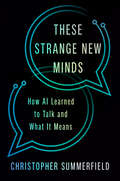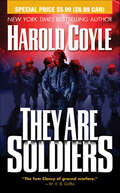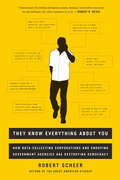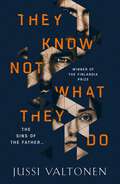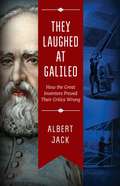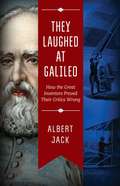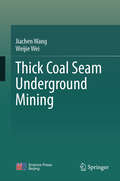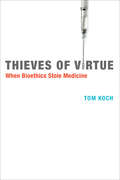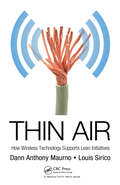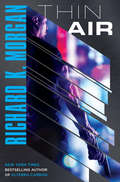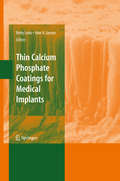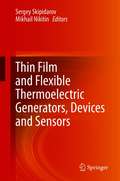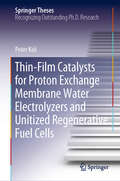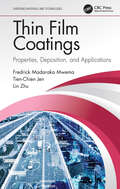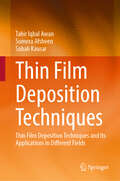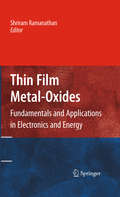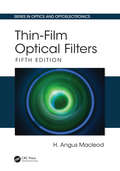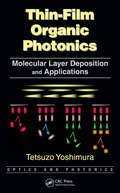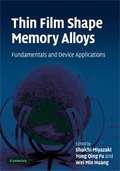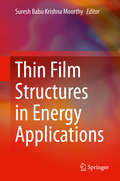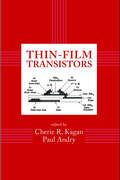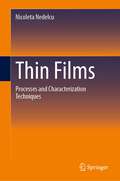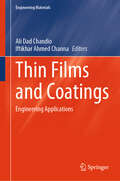- Table View
- List View
These Strange New Minds: How AI Learned to Talk and What It Means
by Christopher SummerfieldAn insider look at the Large Language Models (LLMs) that are revolutionizing our relationship to technology, exploring their surprising history, what they can and should do for us today, and where they will go in the future—from an AI pioneer and neuroscientistIn this accessible, up-to-date, and authoritative examination of the world&’s most radical technology, neuroscientist and AI researcher Christopher Summerfield explores what it really takes to build a brain from scratch. We have entered a world in which disarmingly human-like chatbots, such as ChatGPT, Claude and Bard, appear to be able to talk and reason like us - and are beginning to transform everything we do. But can AI &‘think&’, 'know' and &‘understand&’? What are its values? Whose biases is it perpetuating? Can it lie and if so, could we tell? Does their arrival threaten our very existence?These Strange New Minds charts the evolution of intelligent talking machines and provides us with the tools to understand how they work and how we can use them. Ultimately, armed with an understanding of AI&’s mysterious inner workings, we can begin to grapple with the existential question of our age: have we written ourselves out of history or is a technological utopia ahead?
They Are Soldiers (Nathan Dixon #4)
by Harold CoyleFrom Harold Coyle, the New York Times bestselling author of Twice the Citizen, comes the fourth book in the Nathan Dixon series: They Are SoldiersThey are your neighbor and the person who delivers your mail. They teach your children and build your homes. Every day you see them but do not notice them, that is not until they are needed. Only when disasters strike, whether it be natural or man made do they become something quite different, something more than a fellow citizen. Throughout our nation's history they have been called many things; the militia, the home guard, the National Guard. But regardless of their title they have always been unique, something more than ordinary people. Their willingness to be both a good citizen in peace and a warrior when called upon make them soldiers. The nature of the mission, to man a security zone that separates the nation of Israel from the newly created Palestinian state present him and the Guardsmen of Company A with a unique set of problems few are able to predict. Together the professional officer and the citizen soldiers he leads must find a way to navigate their way toward an uncertain future in a troubled land. Part of that future involves dealing with those who are determined to use the arrival of the Americans to further their own political and personal goals. One of these men is Hammed Kamel, a microbiologist who seizes upon the introduction of American forces in a place some still call the Holy Lands as an opportunity to strike a telling blow against the two nations who have oppressed his people, the Palestinians for decades. Together with a crops of like minded men, Kamel sets in motion a train of events that places the citizen soldiers of Bedlow, Virginia and their community on the other side of the world in jeopardy.At the Publisher's request, this title is being sold without Digital Rights Management Software (DRM) applied.
They Know Everything About You: How Data-Collecting Corporations and Snooping Government Agencies Are Destroying Democracy
by Robert Scheer Sara BeladiThey Know Everything About You is a groundbreaking exposé of how government agencies and tech corporations monitor virtually every aspect of our lives, and a fierce defense of privacy and democracy. The revelation that the government has access to a vast trove of personal online data demonstrates that we already live in a surveillance society. But the erosion of privacy rights extends far beyond big government. Intelligence agencies such as the NSA and CIA are using Silicon Valley corporate partners as their data spies. Seemingly progressive tech companies are joining forces with snooping government agencies to create a brave new world of wired tyranny. Life in the digital age poses an unprecedented challenge to our constitutional liberties, which guarantee a wall of privacy between the individual and the government. The basic assumption of democracy requires the ability of the individual to experiment with ideas and associations within a protected zone, as secured by the Constitution. The unobserved moment embodies the most basic of human rights, yet it is being squandered in the name of national security and consumer convenience. Robert Scheer argues that the information revolution, while a source of public enlightenment, contains the seeds of freedom’s destruction in the form of a surveillance state that exceeds the wildest dream of the most ingenious dictator. The technology of surveillance, unless vigorously resisted, represents an existential threat to the liberation of the human spirit.
They Know Not What They Do
by Jussi ValtonenA FAMILY UNDER THREAT. A FATHER'S WORST NIGHTMARE... On the surface, Joe Chayefski has it all. A great job, a beautiful wife and two perfect daughters. But when the lab he works in as a neuroscientist is attacked, Joe is forced to face the past and reconnect with the son he abandoned twenty years earlier. As Joe struggles to deal with the sudden collision of his two lives, he soon finds he needs to take drastic action to save the people he loves. Gripping and suspenseful, They Know Not What They Do skilfully weaves together the big issues of the day- the relationship between science and ethics, and people's increasing inability to communicate - into an ambitious page-turner of a novel.
They Laughed at Galileo
by Albert JackThey Laughed at Galileo takes a humorous and reflective look at one thousand years of the development of humankind. Those who dreamt, those who taught, those who opposed, and those who, ultimately, did. At some point in modern history each and every one of our inventions and discoveries was thought up in the first place and then developed by a single person, or a handful of people, who dreamt of the seemingly impossible. For them the future was clear and obvious, but for the vast majority, including the acknowledged experts of their day, such belief was sheer folly. For just about everything that has improved our modern lifestyles in a way that our ancestors could not possibly imagine, there was once a dreamer opposed by a team of experts publicly declaring that "It cannot be done." Well, yes it could. The radio, crude oil, show business, high-powered trains and high-flying airplanes, computers, medicine, and nuclear energy-each of these inventions have had a profound effect on the course of human history, and each one was rejected, resisted, and ridiculed by the leading "experts" of the time. Ultimately the inventors and innovators who brought these into existence provided invaluable contributions to science and the culture of humankind.
They Laughed at Galileo: How the Great Inventors Proved Their Critics Wrong
by Albert JackA humorous account of great inventors and their critics who predicted failure.They Laughed at Galileo takes a humorous and reflective look at one thousand years of the development of humankind: those who dreamt, those who taught, those who opposed, and those who, ultimately, did.At some point in modern history, each and every one of our inventions and discoveries was first envisioned and then developed by a single person, or a handful of people, who dreamt of the seemingly impossible. For them, the future was clear and obvious, but for the vast majority, including the acknowledged experts of their days, such belief was sheer folly.For just about everything that has improved our modern lifestyles in a way that our ancestors could not possibly imagine, there was once a lone dreamer proclaiming, "It can be done.” That dreamer was nearly always opposed by a team of "enlightened” contemporaries publicly declaring, "It cannot be done.” Well, yes it could.Marconi’s wireless radio transmissions were initially deemed pointless. Edward L. Drake’s eventual success on August 27, 1859, was called the day "the crazy man first struck oil.” Louis Pasteur’s theory of germs was considered a "ridiculous fiction.” Each of these inventions has had a profound effect on the course of human history, and each one was rejected, resisted, and ridiculed in its day. Ultimately, the innovators who brought these into existence provided invaluable contributions to science and the culture of humankind.
Thick Coal Seam Underground Mining
by Jiachen Wang Weijie WeiThis book systematically summarizes the main technology and latest advancements of China's thick coal seam underground mining technology. It covers the mine development methods, the top coal caving technology and drawing mechanism, the measurement of top coal recovery and technology to improve the recovery ratio, the large mining height technology and coal wall stability control, large cross-section roadway support technology, slicing mining technology and roadway layout, intelligent mining technology and advancements, theories and techniques for controlling surrounding rock in thick coal seam, as well as some typical cases of top coal caving and large mining height. This book can serve as a teaching reference for graduate students in mining engineering and senior undergraduate students at higher education institutions. It is also suitable for researchers, engineering technicians, designers, and relevant technology management personnel engaged in coal mining.
Thieves of Virtue: When Bioethics Stole Medicine (Basic Bioethics)
by Tom KochAn argument against the “lifeboat ethic” of contemporary bioethics that views medicine as a commodity rather than a tradition of care and caring.Bioethics emerged in the 1960s from a conviction that physicians and researchers needed the guidance of philosophers in handling the issues raised by technological advances in medicine. It blossomed as a response to the perceived doctor-knows-best paternalism of the traditional medical ethic and today plays a critical role in health policies and treatment decisions. Bioethics claimed to offer a set of generally applicable, universally accepted guidelines that would simplify complex situations. In Thieves of Virtue, Tom Koch contends that bioethics has failed to deliver on its promises. Instead, he argues, bioethics has promoted a view of medicine as a commodity whose delivery is predicated not on care but on economic efficiency.At the heart of bioethics, Koch writes, is a “lifeboat ethic” that assumes “scarcity” of medical resources is a natural condition rather than the result of prior economic, political, and social choices. The idea of natural scarcity requiring ethical triage signaled a shift in ethical emphasis from patient care and the physician's responsibility for it to neoliberal accountancies and the promotion of research as the preeminent good. The solution to the failure of bioethics is not a new set of simplistic principles. Koch points the way to a transformed medical ethics that is humanist, responsible, and defensible.
Thin Air: How Wireless Technology Supports Lean Initiatives
by Dann Anthony Maurno Louis SiricoAlthough Lean and wireless professionals seek the same goals, few are fluent in each other‘s language. Those who are have already helped their companies tap into the competitive advantages possible by integrating wireless technology into a Lean culture of continuous process improvement. Highlighting wireless as a powerful and inherently Lean tool,
Thin Air: A Novel
by Richard K. MorganAn atmospheric tale of corruption and abduction set on Mars, from the author of the award-winning science fiction novel Altered Carbon, now an exciting new series from Netflix. From the moment Richard K. Morgan’s dazzling debut, Altered Carbon, burst onto the scene, it was clear that a distinctive new voice had arrived to shake up science fiction. His subsequent novels—including the sequels Broken Angels and Woken Furies—confirmed him as a master of hard-boiled futuristic thrillers. Now Morgan returns to the world of SF noir with a riveting tale of crime, corruption, and deadly crisis on a planet teetering close to the edge. On a Mars where ruthless corporate interests violently collide with a homegrown independence movement as Earth-based overlords battle for profits and power, Hakan Veil is an ex–professional enforcer equipped with military-grade body tech that’s made him a human killing machine. But he’s had enough of the turbulent red planet, and all he wants is a ticket back home—which is just what he’s offered by the Earth Oversight organization, in exchange for being the bodyguard for an EO investigator. It’s a beyond-easy gig for a heavy hitter like Veil . . . until it isn’t. When Veil’s charge, Madison Madekwe, starts looking into the mysterious disappearance of a lottery winner, she stirs up a hornet’s nest of intrigue and murder. And the deeper Veil is drawn into the dangerous game being played, the more long-buried secrets claw their way to the Martian surface. Now it’s the expert assassin on the wrong end of a lethal weapon—as Veil stands targeted by powerful enemies hellbent on taking him down, by any means necessary.
Thin Calcium Phosphate Coatings for Medical Implants
by Betty León John JansenThis book presents for the first time, the scattered novel results that have been achieved in very recent years in study on various thin calcium phosphate coatings produced by very diverse techniques. The comparison of thin calcium phosphate coatings with the thick plasma-sprayed ones is also included in the book. Readers will find a comprehensive book reviewing the state-of-the-art of the field with critical assessment of the achievements of the different preparation techniques.
Thin Film and Flexible Thermoelectric Generators, Devices and Sensors
by Sergey Skipidarov Mikhail NikitinThis book presents and facilitates new research and development results with hot topics in the thermoelectric generators (TEGs) field. Topics include: novel thin film; multilayer, composite and nanostructured thermoelectric materials; simulation of phenomena related to thermoelectricity; thermoelectric thin film and multilayer materials manufacturing technologies; measurement techniques for characterization; thermoelectric generators; and the simulation, modeling, design, thermal, and mechanical degradation problems. This book helps researchers tackle the challenges that still remain in creating cheap and effective TEGs and presents the latest trends and technologies in development and production of advanced thermoelectric generation devices.
Thin-Film Catalysts for Proton Exchange Membrane Water Electrolyzers and Unitized Regenerative Fuel Cells (Springer Theses)
by Peter KúšThis work revolves around the hydrogen economy and energy-storage electrochemical systems. More specifically, it investigates the possibility of using magnetron sputtering for deposition of efficient thin-film anode catalysts with low noble metal content for proton exchange membrane water electrolyzers (PEM-WEs) and unitized regenerative fuel cells (PEM-URFCs). The motivation for this research derives from the urgent need to minimize the price of such electrochemical devices should they enter the mass production. Numerous experiments were carried out, correlating the actual in-cell performance with the varying position of thin-film catalyst within the membrane electrode assembly, with the composition of high-surface support sublayer and with the chemical structure of the catalyst itself. The wide arsenal of analytical methods ranging from electrochemical impedance spectroscopy through electrochemical atomic force microscopy to photoelectron spectroscopy allowed a description of the complex phenomena behind different obtained efficiencies. Systematic optimizations led to the design of a novel PEM-WE anode thin-film iridium catalyst which performs similarly to the standard counterparts despite using just a fraction of their noble metal content. Moreover, the layer-by-layer approach allowed the design of a Pt/TiC/Ir bi-functional anode for PEM-URFC which is able to operate in both the fuel cell and electrolyzer regime and thus helps to cut the cost of the whole conversion system even further.
Thin Film Coatings: Properties, Deposition, and Applications (Emerging Materials and Technologies)
by Fredrick Madaraka Mwema Tien-Chien Jen Lin ZhuThin Film Coatings: Properties, Deposition, and Applications discusses the holistic subject of conventional and emerging thin film technologies without bias to a specific technology based on the existing literature. It covers properties and delves into the various methods of thin film deposition, including the most recent techniques and a direction for future developments. It also discusses the cutting-edge applications of thin film coatings such as self-healing and smart coatings, biomedical, hybrid, and scalable thin films. Finally, the concept of Industry 4.0 in thin film coating technology is examined. This book: Explores a wide range and is not specific to material and method of deposition Demonstrates the application of thin film coatings in nearly all sectors, such as energy and anti-microbial applications Details the preparation and properties of hybrid and scalable (ultra) thin materials for advanced applications Provides detailed bibliometric analyses on applications of thin film coatings Discusses Industry 4.0 and 3D printing in thin film technology With its broad coverage, this comprehensive reference will appeal to a wide audience of materials scientists and engineers and others studying and developing advanced thin film technologies.
Thin Film Deposition Techniques: Thin Film Deposition Techniques and Its Applications in Different Fields
by Tahir Iqbal Awan Sumera Afsheen Sabah KausarThis book describes the basics and historical aspects of thin film. The introductory chapter of this book contains various aspects about thin-film deposition methods, significance of nanomaterials in the fabrication of thin film, certain fundamental characteristics of thin films (electrical, optical, and morphological), some challenges (thickness uniformity, film adhesion issues, temperature-related challenges, film defects and quality control, preparation of the surface of the substrate before deposition, etc.) faced during the formation of thin film, significance, and different types of deposition techniques along with their basic introduction, working principle, construction, merits/demerits, and also application in specific fields. This book specifically works on the techniques of thin-film deposition and role of the thin film in the formation of these deposition methods.
Thin Film Metal-Oxides
by Shriram RamanathanThin Film Metal-Oxides provides a representative account of the fundamental structure-property relations in oxide thin films. Functional properties of thin film oxides are discussed in the context of applications in emerging electronics and renewable energy technologies. Readers will find a detailed description of deposition and characterization of metal oxide thin films, theoretical treatment of select properties and their functional performance in solid state devices, from leading researchers. Scientists and engineers involved with oxide semiconductors, electronic materials and alternative energy will find Thin Film Metal-Oxides a useful reference.
Thin-Film Optical Filters (Series in Optics and Optoelectronics)
by H. Angus MacleodPraise for prior editions "an excellent treatise of thin film coatings, explaining how to produce all sorts of different filters selected according to the function they are required to play… an indispensable text for every filter manufacturer and user and an excellent guide for students." ―Contemporary Physics "essential reading for all those involved in the design, manufacture, and application of optical coatings" ―Materials World "a must-have addition to the library of any optical thin-film theorist or practitioner" ―SVC News This book is quite simply the Bible for the field of optical thin films. It gives the most complete introduction to thin film optical coatings addressed to manufacturers and users alike. This fifth edition offers a complete update on current design, manufacture, performance, and applications. New topics include absorbers and coherent perfect absorbers, photonic crystals, and metamaterials for optical coating. The author has also made substantial additions on scattering, composite materials, wire grid polarizers, laser damage, and applications. H. Angus Macleod is President of Thin Film Center Inc., in Tucson, Arizona, and Professor Emeritus of Optical Sciences Center at the University of Arizona. His professional honors include a Gold Medal from SPIE, the Esther Hoffman Beller Medal from the Optical Society of America, and the Nathaniel H. Sugerman Memorial Award from the Society of Vacuum Coaters.
Thin-Film Organic Photonics: Molecular Layer Deposition and Applications (Optics and Photonics)
by Tetsuzo YoshimuraAmong the many atomic/molecular assembling techniques used to develop artificial materials, molecular layer deposition (MLD) continues to receive special attention as the next-generation growth technique for organic thin-film materials used in photonics and electronics. Thin-Film Organic Photonics: Molecular Layer Deposition and Applications describes how photonic/electronic properties of thin films can be improved through MLD, which enables precise control of atomic and molecular arrangements to construct a wire network that achieves "three-dimensional growth". MLD facilitates dot-by-dot—or molecule-by-molecule—growth of polymer and molecular wires, and that enhanced level of control creates numerous application possibilities. Explores the wide range of MLD applications in solar energy and optics, as well as proposed uses in biomedical photonics This book addresses the prospects for artificial materials with atomic/molecular-level tailored structures, especially those featuring MLD and conjugated polymers with multiple quantum dots (MQDs), or polymer MQDs. In particular, the author focuses on the application of artificial organic thin films to: Photonics/electronics, particularly in optical interconnects used in computersOptical switching and solar energy conversion systems Bio/ medical photonics, such as photodynamic therapy Organic photonic materials, devices, and integration processes With its clear and concise presentation, this book demonstrates exactly how MLD enables electron wavefunction control, thereby improving material performance and generating new photonic/electronic phenomena.
Thin Film Shape Memory Alloys
by Shuichi Miyazaki Yong Qing Fu Wei Min HuangThis book, the first dedicated to this exciting and rapidly growing field, enables readers to understand and prepare high-quality, high-performance TiNi shape memory alloys (SMAs). It covers the properties, preparation and characterization of TiNi SMAs, with particular focus on the latest technologies and applications in MEMS and biological devices. Basic techniques and theory are covered to introduce new-comers to the subject, whilst various sub-topics, such as film deposition, characterization, post treatment, and applying thin films to practical situations, appeal to more informed readers. Each chapter is written by expert authors, providing an overview of each topic and summarizing all the latest developments, making this an ideal reference for practitioners and researchers alike.
Thin Film Structures in Energy Applications
by Suresh Babu Krishna MoorthyThis book provides a comprehensive overview of thin film structures in energy applications. Each chapter contains both fundamentals principles for each thin film structure as well as the relevant energy application technologies. The authors cover thin films for a variety of energy sectors including inorganic and organic solar cells, DSSCs, solid oxide fuel cells, thermoelectrics, phosphors and cutting tools.
Thin Film Transistor Circuits and Systems
by Reza Chaji Arokia NathanProviding a reliable and consolidated treatment of the principles behind large-area electronics, this book provides a comprehensive review of the design challenges associated with building circuits and systems from thin-film transistors. The authors describe the architecture, fabrication and design considerations for the principal types of TFT and their numerous applications. The practicalities of device non-ideality are also addressed and the specific design considerations necessitated by instabilities and non-uniformities in existing fabrication technologies. Containing device-circuit information, discussion of electronic solutions that compensate for material deficiencies, and design methodologies applicable to a wide variety of organic and inorganic disordered materials, this is an essential reference for all researchers, circuit and device engineers working on large-area electronics.
Thin-Film Transistors
by Cherie R. Kagan Paul AndryThis is a single-source treatment of developments in TFT production from international specialists. It interweaves overlapping areas in multiple disciplines pertinent to transistor fabrication and explores the killer application of amorphous silicon transistors in active matrix liquid crystal displays. It evaluates the preparation of polycrystallin
Thin Films: Processes and Characterization Techniques
by Nicoleta NedelcuThe book provides research scientists and engineers in industry information and data on the materials processing, characterization, and determination of materials’ physical-chemical properties. The book highlights optical and chemical properties obtained on novel materials using a range of deposition methods by two different spectroscopic techniques: SE and UV-VIS-NIR. Emphasizing applications from across a number of domains including Healthcare, Opto-Electronic, and Defense, the book is ideal for academic researchers, graduate/undergraduate students, and practicing engineers concerned with optical coating technologies.
Thin Films and Coatings: Engineering Applications (Engineering Materials)
by Ali Dad Chandio Iftikhar Ahmed ChannaThis book highlights the fundamentals of thin films and coatings, including deposition techniques and material properties. The book showcases real-world applications in electronics, optics, nanotechnology, and aerospace, highlighting how these materials improve performance and durability. It also explores emerging trends such as smart coatings and sustainable options, making it a comprehensive resource for those seeking to leverage the potential of thin films and coatings in engineering. With both theoretical foundations and practical insights, it is a valuable reference for researchers and professionals in this dynamic field.
